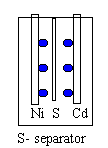| My cells died. I was nice to them, what happened? |  |
| I’ve seen people talk about zapping cells to revive them? | |
| How about self-discharge? | |
| What about NiMH cells? | |
| What if I want to learn even more about NiCds and other batteries? | (See Below) |
Q:
My cells died. I was nice to them, what happened?
A:
All good things must come to an end. No matter how well one takes care of the
cells, they will eventually die. There are two main reasons cells fail, other
than abuse. One is separator failure, and the other is degradation of the active
material. The first is far more common, and the result is a shorted cell. Every
time a cell is charged, the active material is redeposited on the plates.
Ideally, this occurs uniformly across the surface of the plate. However, in
reality, there will be bumps and valleys. When there are bumps on both the
positive and negative plates are adjacent, separated only by the separator, the
resistance between those two points is slightly less than in other regions of
the cell. So, the current density there rises. This means that more material is
deposited there, contributing to even more “bumpiness”. In reality, needles
called dendrites form, and given time, they can force themselves through the
separator to short the cell. A cell that appears to self-discharge in a couple
of days has dendrite problems, and will soon completely short out. Plan to
replace the cell. Degradation of the active plate material is just a normal
aging process of cycling. Both of these mechanisms are very good reasons to
avoid cycling the cells after each use. Cells should live to about 1000 cycles
if treated properly. Anything over that is gravy.
Q: I’ve seen people talk about zapping cells to revive them?
A: Yes—a quick fix it. When cells short due to dendrites, the piece of material that is actually shorting the cell is very thin. So, by forcing a huge impulse of current into the cell, one can vaporize the dendrite—sort of blowing a fuse. This works, and can revive an otherwise shorted cell. However, it is a stopgap measure at best. First, the fact that one dendrite has formed means that another is not too far behind. Second, the material that was vaporized has now permeated the separator material, forming a resistor that shorts the plates. The cell may no longer be shorted, but will still have poor charge retention. Besides, unless done properly, this can be dangerous as large currents are necessary.
Q: How about self-discharge?
A: Yes, NiCds have a bad habit of going dead when you just leave them. Fortunately you can recharge them. The current cells discharge about 1 percent a day, maybe a bit less. Expect them to be mostly flat after 3 months. Unfortunately, the so-called 15-hour trickle chargers more than make up for self-discharge. In fact most of the current goes to making oxygen, not making up for self-discharge. If you want to make something to keep your cells from self-discharging, make a 1 to 2 mA current source. That should more than overcome self-discharge.
Q:
What about NiMH cells?
A:
NiMH or nickel metal-hydride cells are a promising alternative to NiCds. They
use hydrides (metals capable of storing hydrogen) as the negative material in
lieu of cadmium. They have higher capacity for the same size cell, and don’t
use toxic cadmium. They also are advertised as not suffering from memory. The downsides:
They are expensive (all new technology is). They have a horrible
self-discharge rate (I have measured between 3 to 10 percent per
day—useless after 1 month). They are trickier to charge. Delta V works,
but the voltage drop is very small (2.5 mV/cell). Better to charge them
to a point where the voltage stops rising. And, yes, the same thing goes with
hydrides as with cadmium. They can suffer from memory, though it is much harder
to see than in NiCds. Expect to see a bit less touting of the “memory free”
operation of NiMH cells in the future.
Q: What if I want to learn even more about NiCds and other batteries?
A: There are several good texts on batteries. One is quite new and contains fairly contemporary material: Maintenance-Free Batteries by D. Berndt, Research Studies Press, Ltd., Taunton, Somerset, England in conjunction with J. Wiley & Sons, New York, 1993. ISBN 0-86380-143-9.
![]() > VHFHomepage >Care
> VHFHomepage >Care